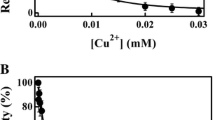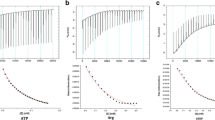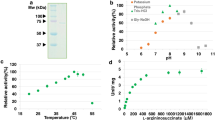Abstract
Paramecium tetraurelia expresses four types of arginine kinase (AK1–AK4). In a previous study, we showed that AK3 is characterized by typical arginine substrate inhibition, where enzymatic activity markedly decreases near a concentration of 1 mM of arginine substrate. This is in sharp contrast to the three other AK types, which obey the Michaelis–Menten reaction curve. Since cellular arginine concentration in another ciliate Tetrahymena is estimated to be 3–15 mM in vivo, Paramecium AK3 likely functions in conditions that are strongly affected by substrate inhibition. The purpose of this work is to find some novel aspect on the kinetic mechanism of the substrate inhibition of Paramecium AK3 enzyme. Substrate inhibition kinetics for AK3 were analyzed using three models and their validity were evaluated with three static parameters (R2, AICc, and Sy.x). The most accurate model indicated that not only ES but also the SES complex reacts to form products, the latter being the complex with two substrates in the active center. The maximum reaction rate for the SES complex, VmaxSES = 30.4 µmol Pi/min/mg protein, was one-eighth of the ES complex, VmaxES = 241.7. The dissociation constant for the SES complex (KiSES: 0.34 mM) was two times smaller than that of the ES complex (KsES: 0.61 mM), suggesting that after the primary binding of the arginine substrate (ES complex formation), the binding of a second arginine to the secondarily induced inhibitory site is accelerated to form an SES complex with a lower VmaxSES. The same kinetics were used for the S79A, S80A, and V81A mutants. The results indicate that the S79 residue is significantly involved in the process of binding the second arginine substrate. Herein, the KiSES value was ten times (3.62 mM) the value for the wild-type (0.34 mM), weakening substrate inhibition. In contrast, VmaxES and VmaxSES values for the mutants decreased by one-third, except for the VmaxSES of the S79A mutant, which had a value that was comparable with the value for the wild-type.







Similar content being viewed by others
Abbreviations
- AK:
-
Arginine kinase
- PK:
-
Phosphagen kinase
References
Chaplin M, Bucke C (1990) Enzyme technology (chap. 1: fundamentals of enzyme kinetics). Cambridge University Press, Cambridge
Reed MC, Lieb A, Nijhout HF (2010) The biological significance of substrateinhibition: a mechanism with diverse functions. Bioessays 32:422–429
Stambaugh R, Post D (1966) Substrate and product inhibition of rabbit muscle lactic dehydrogenase heart (H4) and muscle (M4) isozymes. J Biol Chem 241:1462–1467
van Ophem PW, Erickson SD, Martinez del Pozo A, Haller I, Chait BT, Yoshimura T, Soda K, Ringe D, Petsko G, Manning JM (1998) Substrate inhibition of D-amino acid transaminase and protection by salts and by reduced nicotinamide adenine dinucleotide: isolation and initial characterization of a pyridoxo intermediate related to inactivation. Biochemistry 37:2879–2888
Dauvrin T, Thinès-Sempoux D (1989) Purification and characterization of a heterogeneous glycosylated invertase from the rumen holotrich ciliate Isotricha prostoma. Biochem J 264:721–727
Shafferman A, Velan B, Ordentlich A, Kronman C, Grosfeld H, Leitner M, Flashner Y, Cohen S, Barak D, Ariel N (1992) Substrate inhibition of acetylcholinesterase: residues affecting signal transduction from the surface to the catalytic center. EMBO J 11:3561–3568
Kühl PW (1994) Excess-substrate inhibition in enzymology and high-dose inhibition in pharmacology: a reinterpretation. Biochem J 298:171–180
Eggert MW, Byrne ME, Chambers RP (2011) Impact of high pyruvate concentration on kinetics of rabbit muscle lactate dehydrogenase. Appl Biochem Biotechnol 165:676–686
Yoshino M, Murakami K (2015) Analysis of the substrate inhibition of complete and partial types. SpringerPlus 4:292
Shen P, Larter R (1994) Role of substrate inhibition kinetics in enzymatic chemical oscillations. Biophys J 67:1414–1428
Nakashima A, Mori K, Suzuki T, Kurita H, Otani M, Nagatsu T, Ota A (1999) Dopamine inhibition of human tyrosine hydroxylase type 1 is controlled by the specific portion in the N-terminus of the enzyme. J Neurochem 72:2145–2153
Lin Y, Lu P, Tang C, Mei Q, Sandig G, Rodrigues AD, Rushmore TH, Shou M (2001) Substrate inhibition kinetics for cytochrome P450-catalyzed reactions. Drug Metab Dispos 29:368–374
Stojan J, Brochier L, Alies C, Colletier JP, Fournier D (2004) Inhibition of Drosophila melanogaster acetylcholinesterase by high concentrations of substrate. Eur J Biochem 271:1364–1371
Ellington WR (2001) Evolution and physiological roles of phosphagen systems. Ann Rev Physiol 63:289–325
Ellington WR, Suzuki T (2006) Evolution and divergence of creatine kinase genes. In: Vial C (ed) Molecular anatomy and physiology of proteins: creatine kinase. Nova Science, New York, pp 1–27
Uda K, Fujimoto N, Akiyama Y, Mizuta K, Tanaka K, Ellington WR, Suzuki T (2006) Evolution of the arginine kinase gene family. Comp Biochem Physiol D 1:209–218
Andrews LD, Graham J, Snider MJ, Fraga D (2008) Characterization of a novel bacterial arginine kinase from Desulfotalea psychrophila. Comp Biochem Physiol B 150:312–319
Suzuki T, Soga S, Inoue M, Uda K (2013) Characterization and origin of bacterial arginine kinases. Int J Biol Macromol 57:273–277
Michibata J, Okazaki N, Motomura S, Uda K, Fujiwara S, Suzuki T (2014) Two arginine kinases of Tetrahymena pyriformis: characterization and localization. Comp Biochem Physiol B 171:34–41
Okazaki N, Motomura S, Okazoe N, Yano D, Suzuki T (2015) Cooperativity and evolution of Tetrahymena two-domain arginine kinase. Int J Biol Macromol 79:696–703
Motomura S, Suzuki T (2016) Evidence for N-terminal myristoylation of Tetrahymena arginine kinase using peptide mass fingerprinting analysis. Protein J 35:212–217
Yano D, Suzuki T, Hirokawa S, Fuke K, Suzuki T (2017) Characterization of four arginine kinases in the ciliate Paramecium tetraurelia: investigation on the substrate inhibition mechanism. Int J Biol Macromol 101:653–659
Wu C, Hogg JF (1956) Free and nonprotein amino acids of Tetrahymena pyriformis. Arch Biochem Biophys 62:70–77
Yamashiro Y (2014) Studies on serine racemase homologue in Tetrahymena thermophila (in Japanese). Master thesis, Graduate School of Integrated Arts and Sciences, Kochi University (Japan)
Arnaiz O, Malinowska A, Klotz C, Sperling L, Dadlez M, Koll F, Cohen J (2009) Cildb: a knowledgebase for centrosomes and cilia. Database (Oxford) 2009:bap022
Yano J, Rajendran A, Valentine MS, Saha M, Ballif BA, Van Houten JL (2013) Proteomic analysis of the cilia membrane of Paramecium tetraurelia. J Proteom 78:113–122
Suzuki T, Kawasaki Y, Furukohri T, Ellington WR (1997) Evolution of phosphagenkinase. VI. Isolation characterization and cDNA-derived aminoacid sepuence oflombricine kinase from earthworm Eisenia foetida, andidentification of possible candate for guanidine substrate recognition site. Biochim Biophys Acta 1348:152–159
Zhou G, Somasundaram T, Blanc E, Parthasarathy G, Ellington WR, Chapman MS (1998) Transition state structure of arginine kinase: implications for catalysis of bimolecular reactions. Proc Natl Acad Sci USA 95:8449–8454
Acknowledgements
This work was supported by a Grant-in-Aid for Scientific Research from the Ministry of Education, Culture, Sports, Science, and Technology, Japan to TS (15K07151).
Author information
Authors and Affiliations
Corresponding author
Ethics declarations
Conflict of interest
The authors declare that they have no conflict of interest.
Research Involving Human and Animal Participants
This article does not contain any studies with human participants or animals performed by any of the authors.
Rights and permissions
About this article
Cite this article
Yano, D., Suzuki, T. Kinetic Analyses of the Substrate Inhibition of Paramecium Arginine Kinase. Protein J 37, 581–588 (2018). https://doi.org/10.1007/s10930-018-9798-2
Published:
Issue Date:
DOI: https://doi.org/10.1007/s10930-018-9798-2




